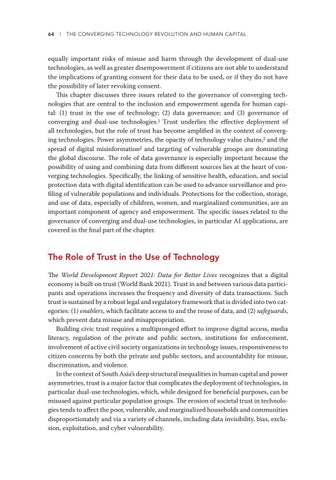64 l THE CONVERGING TECHNOLOGY REVOLUTION AND HUMAN CAPITAL
equally important risks of misuse and harm through the development of dual-use technologies, as well as greater disempowerment if citizens are not able to understand the implications of granting consent for their data to be used, or if they do not have the possibility of later revoking consent. This chapter discusses three issues related to the governance of converging technologies that are central to the inclusion and empowerment agenda for human capital: (1) trust in the use of technology; (2) data governance; and (3) governance of converging and dual-use technologies.1 Trust underlies the effective deployment of all technologies, but the role of trust has become amplified in the context of converging technologies. Power asymmetries, the opacity of technology value chains,2 and the spread of digital misinformation3 and targeting of vulnerable groups are dominating the global discourse. The role of data governance is especially important because the possibility of using and combining data from different sources lies at the heart of converging technologies. Specifically, the linking of sensitive health, education, and social protection data with digital identification can be used to advance surveillance and profiling of vulnerable populations and individuals. Protections for the collection, storage, and use of data, especially of children, women, and marginalized communities, are an important component of agency and empowerment. The specific issues related to the governance of converging and dual-use technologies, in particular AI applications, are covered in the final part of the chapter.
The Role of Trust in the Use of Technology The World Development Report 2021: Data for Better Lives recognizes that a digital economy is built on trust (World Bank 2021). Trust in and between various data participants and operations increases the frequency and diversity of data transactions. Such trust is sustained by a robust legal and regulatory framework that is divided into two categories: (1) enablers, which facilitate access to and the reuse of data, and (2) safeguards, which prevent data misuse and misappropriation. Building civic trust requires a multipronged effort to improve digital access, media literacy, regulation of the private and public sectors, institutions for enforcement, involvement of active civil society organizations in technology issues, responsiveness to citizen concerns by both the private and public sectors, and accountability for misuse, discrimination, and violence. In the context of South Asia’s deep structural inequalities in human capital and power asymmetries, trust is a major factor that complicates the deployment of technologies, in particular dual-use technologies, which, while designed for beneficial purposes, can be misused against particular population groups. The erosion of societal trust in technologies tends to affect the poor, vulnerable, and marginalized households and communities disproportionately and via a variety of channels, including data invisibility, bias, exclusion, exploitation, and cyber vulnerability.

